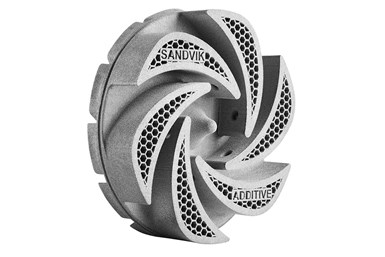Sandvik’s Cemented Carbide Offers Wear Resistance, Design Freedom
Company says its cemented carbide is one of the hardest materials available in 3D printed shape.

3D printed cemented carbide component. Photo Credit: Sandvik
Sandvik is expanding its additive materials offering to include 3D printed components in cemented carbide, which is said to provide superior wear-resistant properties. The material is said to have a unique character as a result of its composite structure — a wear-resistant phase bonded together by a ductile binder metal.
It is said that due to its inherent hardness, cemented carbides can be challenging to machine, not least in complex geometries. Utilizing Sandvik’s 3D printed cemented carbide for additive manufacturing (AM) is said to offer users increased design freedom, decreased material waste and fewer replacements that come with AM technology.
According to the company, the powder is optimized to print components that look great, work well and are fit for use in actual applications, demanding environments and serial production. It is also said the ability to 3D print cemented carbide can dramatically speed up time-to-market. Where prototyping used to take 6-12 months, the company says that lead time can be reduced to just a matter of weeks.
When implementing it for AM, it said to virtually eliminate all previous design restrictions, enabling users to focus on designing components based on operational needs and requirements, without having to adapt to a specific shape or form. This is said to enable product optimization that would have been impossible to achieve without AM.
It is also said the material’s durability makes it well suited for most industries looking to optimize production efficiency, including those operating in challenging environments. This includes a variety industries such as metal cutting, agriculture, food, and oil and gas.
Related Content
-
AM 101: What Is Binder Jetting? (Includes Video)
Binder jetting requires no support structures, is accurate and repeatable, and is said to eliminate dimensional distortion problems common in some high-heat 3D technologies. Here is a look at how binder jetting works and its benefits for additive manufacturing.
-
Additive Manufacturing Is Subtractive, Too: How CNC Machining Integrates With AM (Includes Video)
For Keselowski Advanced Manufacturing, succeeding with laser powder bed fusion as a production process means developing a machine shop that is responsive to, and moves at the pacing of, metal 3D printing.
-
3D Printed NASA Thrust Chamber Assembly Combines Two Metal Processes: The Cool Parts Show #71
Laser powder bed fusion and directed energy deposition combine for an integrated multimetal rocket propulsion system that will save cost and time for NASA. The Cool Parts Show visits NASA’s Marshall Space Flight Center.













